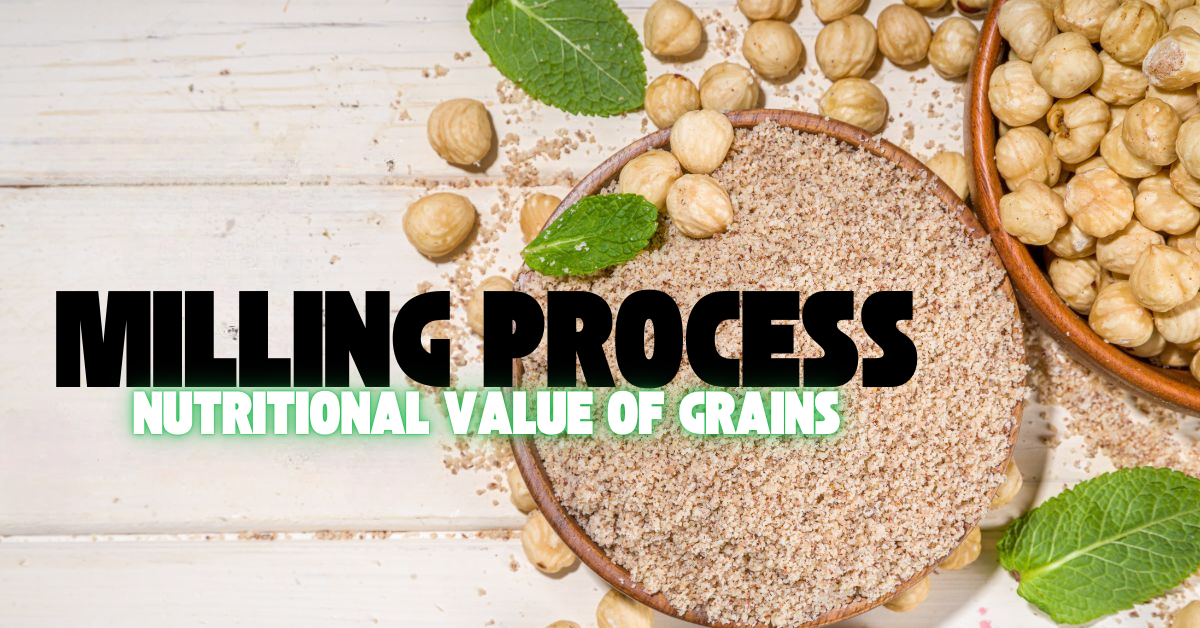The milling process can significantly affect the nutritional value of grains by altering the composition of the grain’s components. Milling typically involves the removal of the bran, germ, and sometimes part of the endosperm, which affects the nutrient content. Here’s how the milling process impacts the nutritional profile of grains:
1. Removal of the Bran and Germ
- Loss of Fiber: The bran, which is the outer layer of the grain, is rich in dietary fiber. Milling removes most of the bran, leading to a reduction in fiber content.
- Impact: This results in lower fiber levels in refined grains compared to whole grains, potentially affecting digestive health and contributing to higher glycemic indexes.
- Reduction in Micronutrients: The germ contains essential vitamins, minerals, and antioxidants, including vitamin E, B vitamins (like thiamine, riboflavin, and niacin), and healthy fats.
- Impact: Milling removes a significant portion of these nutrients, reducing the overall nutrient density of the final product.
2. Retention of the Endosperm
- Primary Source of Starch: The endosperm is the central part of the grain and mainly consists of starch, which is a carbohydrate.
- Impact: The milling process retains the starch in refined grains, which provides energy but lacks the protein, fiber, and nutrients present in the bran and germ. This makes the refined grain less nutritionally balanced than whole grains.
- Protein Content: Milling typically reduces the protein content because a portion of the protein is found in the bran and germ.
- Impact: Although refined grains still contain protein, the amount is lower compared to whole grains.
3. Nutrient Density
- Whole Grains: Whole grains retain all three parts—bran, germ, and endosperm—maintaining a higher nutrient density, including fiber, protein, vitamins, minerals, and antioxidants.
- Impact: Whole grains are nutritionally superior to refined grains, offering better overall health benefits, such as improved digestion, lower cholesterol, and better blood sugar control.
- Refined Grains: In contrast, refined grains are less nutrient-dense because the outer layers are removed.
- Impact: This can lead to deficiencies in essential nutrients, especially if refined grains are a major part of the diet.
4. Fortification and Enrichment
- Fortification: Some refined grains are fortified with vitamins and minerals lost during milling (e.g., iron, folic acid, and B vitamins).
- Impact: While fortification helps replace some of the lost nutrients, it cannot fully restore the fiber or many of the phytonutrients present in whole grains.
- Enrichment: This process typically involves adding back specific nutrients like thiamine, riboflavin, niacin, and iron, but it does not replace the fiber content or other micronutrients lost during milling.
5. Glycemic Index
- Higher Glycemic Index (GI): Milling often increases the glycemic index of grains, which refers to how quickly the grain is digested and absorbed, causing a rise in blood sugar levels.
- Impact: Refined grains generally have a higher GI, which may lead to faster spikes in blood sugar compared to whole grains, potentially affecting insulin sensitivity and contributing to conditions like type 2 diabetes.
- Lower GI with Whole Grains: Whole grains tend to have a lower glycemic index because their fiber content slows digestion and absorption.
6. Antioxidants and Phytochemicals
- Loss of Antioxidants: Milling removes many of the antioxidant-rich compounds found in the bran and germ, including phenolic acids, flavonoids, and other phytochemicals.
- Impact: This leads to a reduction in the antioxidant content of refined grains, which are beneficial for protecting the body from oxidative stress and inflammation.
7. Impact on Digestibility
- Easier Digestion of Refined Grains: Refined grains are easier to digest and are more quickly converted into energy, which can be beneficial in some contexts, such as during intense physical activity or for people with certain digestive issues.
- Impact: However, this rapid digestion may contribute to nutrient imbalances if consumed in excess without adequate fiber and micronutrients.
- Whole Grains: Whole grains are more slowly digested, offering prolonged energy release and better satiety.
- Impact: They support more stable blood sugar levels and digestive health.
8. Dietary Considerations
- Dietary Recommendations: Many health organizations recommend consuming more whole grains due to their superior nutritional value and health benefits.
- Impact: A diet rich in whole grains may lower the risk of chronic diseases, such as heart disease, obesity, and certain cancers.









